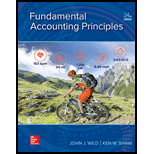
Concept explainers
Concept Introduction:
Ending Work in Process of the departments:
The ending work in process of the department can be defined as the units left in the department after the units are transferred to the next department from the total available units. Total available units are the sum of units in the beginning and the units started in the process.
The ending work in process of the department can be calculated as under −
Ending work in process = Beginning Direct Materials + Beginning Conversion cost + Cost added for Material + Cost added for conversion − Transferred to the next department
Ending work in process inventory accounts for −
- Cutting Department
- Binding Department
Answer to Problem 20QS
Solution:
Ending work in process inventory accounts for −
- Cutting Department = $ 7,100
- Binding Department = $ 17,042
Explanation of Solution
The ending work in process inventory accounts for cutting department and binding department are calculated as under −
1. For cutting Department −
Given,
- Beginning Direct Materials = $ 845
- Beginning Conversion cost = $ 2,600
- Cost added for Material = $ 8,240
- Cost added for conversion = $ 11,100
- Transferred to the binding department = $ 15,685
Ending work in process inventory accounts for cutting Department is −
2. For Binding Department −
Given,
- Beginning WIP from cutting department = $ 1,200
- Beginning Direct Materials = $ 1,926
- Beginning Conversion cost = $ 3,300
- Cost added for Material = $ 6,356
- Cost added for conversion = $ 18,575
- Transferred from cutting department = $ 15,685
- Transferred to the finished goods = $ 30,000
Ending work in process inventory accounts for cutting Department is −
Thus, the ending work in process for cutting and binding departments have been determined.
Want to see more full solutions like this?
Chapter 20 Solutions
FUND.ACCT.PRIN.(LOOSELEAF)-W/ACCESS
- Please provide the correct answer to this financial accounting problem using valid calculations.arrow_forwardCan you solve this general accounting question with the appropriate accounting analysis techniques?arrow_forwardSiemens Technology produces ergonomic keyboards for $75.00 per unit. The variable cost per unit is $27.00. Each keyboard requires 4 direct labor hours and 6 machine hours to produce. Which of the following is the correct contribution margin per machine hour? a) $8.00 b) $12.00 c) $19.00 d) $48.00 e) None of these.arrow_forward
- I need assistance with this general accounting question using appropriate principles.arrow_forwardPlease provide the correct answer to this general accounting problem using accurate calculations.arrow_forwardI need help finding the accurate solution to this general accounting problem with valid methods.arrow_forward
- Please provide the solution to this general accounting question with accurate financial calculations.arrow_forwardPlease explain the solution to this financial accounting problem with accurate principles.arrow_forwardPlease provide the solution to this general accounting question using proper accounting principles.arrow_forward
- I am looking for a reliable way to solve this financial accounting problem using accurate principles.arrow_forwardI am looking for the correct answer to this general accounting question with appropriate explanations.arrow_forwardCan you solve this financial accounting problem using appropriate financial principles?arrow_forward

 AccountingAccountingISBN:9781337272094Author:WARREN, Carl S., Reeve, James M., Duchac, Jonathan E.Publisher:Cengage Learning,
AccountingAccountingISBN:9781337272094Author:WARREN, Carl S., Reeve, James M., Duchac, Jonathan E.Publisher:Cengage Learning, Accounting Information SystemsAccountingISBN:9781337619202Author:Hall, James A.Publisher:Cengage Learning,
Accounting Information SystemsAccountingISBN:9781337619202Author:Hall, James A.Publisher:Cengage Learning, Horngren's Cost Accounting: A Managerial Emphasis...AccountingISBN:9780134475585Author:Srikant M. Datar, Madhav V. RajanPublisher:PEARSON
Horngren's Cost Accounting: A Managerial Emphasis...AccountingISBN:9780134475585Author:Srikant M. Datar, Madhav V. RajanPublisher:PEARSON Intermediate AccountingAccountingISBN:9781259722660Author:J. David Spiceland, Mark W. Nelson, Wayne M ThomasPublisher:McGraw-Hill Education
Intermediate AccountingAccountingISBN:9781259722660Author:J. David Spiceland, Mark W. Nelson, Wayne M ThomasPublisher:McGraw-Hill Education Financial and Managerial AccountingAccountingISBN:9781259726705Author:John J Wild, Ken W. Shaw, Barbara Chiappetta Fundamental Accounting PrinciplesPublisher:McGraw-Hill Education
Financial and Managerial AccountingAccountingISBN:9781259726705Author:John J Wild, Ken W. Shaw, Barbara Chiappetta Fundamental Accounting PrinciplesPublisher:McGraw-Hill Education





